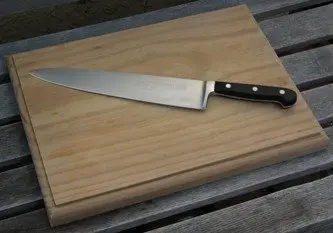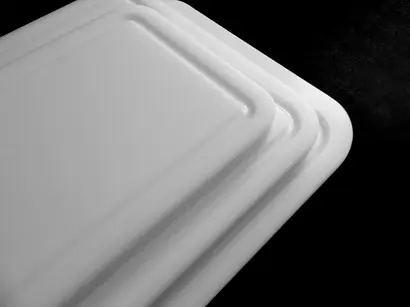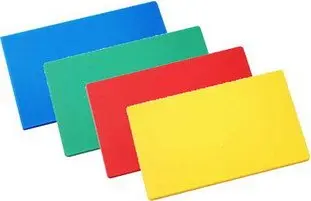The blog of cooking-ez.com
Choosing a chopping board

It's a no-brainer, surely? If you want a chopping board, just find a piece of wood, and Bob's your uncle! You can happily chop away with a knife and not damage the table or worktop. But in reality, it's a bit more complicated than that. You need to be careful what you are buying, in particular the material that the board is made from.
45K 20 4.6
Last modified on: May 8th 2012
Choosing a chopping board
Glass or metal:

You will sometimes see chopping boards made from these materials, generally decorated with an embedded photo or graphic design. It's very simple: just don't buy them! Both materials will blunt your knife very rapidly.
A chopping board should be made of reasonably soft material.
Wood

Hmm... It's tempting to go back to natural materials with an old-fashioned chopping board, like those that have been used since medieval times.

This is an appealing idea, but wooden chopping boards have two problems: the knife cuts into the wood easily, so you end up with a certain amount of “sawdust” in the food you are cutting, and wood is porous, so it can hold smells or flavours, even if it is cleaned very thoroughly (this is pretty disastrous if you cut garlic on it, then follow that with pastry for a dessert, for example – just imagine the mix of flavours…).
A chopping board should be resistant to knife cuts.
Synthetic material

This is without doubt the ideal solution: flexible enough to protect the knife edge, robust enough not to be damaged too quickly. It is easy to clean and does not tend to hold flavours or smells.
The synthetic materials fall into two main groups: high-density polyethylene or HDPE, and polyvinyl chloride or PVC. HDPE is more expensive than PVC, but much more resilient and more neutral, so better for our health.
Most of the cheaper chopping boards on sale in the shops are in PVC and these present much the same problem as wooden ones: they are easily damaged by the knife, so you will soon end up with bits of PVC in your food. It is better to be careful and replace any PVC board which shows too many knife marks.

When it comes to the size, it's quite simple: the bigger the better (as long you can find a place to store it in your kitchen, of course). A board about 30 x 30 cm (12 x 12 inches) and 1 cm (½ inch thick) is a good compromise. A large board is comfortable to use as you can cut things easily and push them to the side as you go. This is more awkward with a small board.
If you buy a board in HDPE from a professional cookware shop (expensive, but the quality will be good), you will have a choice of both size and colour, as restaurant kitchens use different boards for meat, vegetables, fish, etc. and these are colour coded (red = meat, green = vegetables, etc.).

To sum up: For your own kitchen, invest in a board in HDPE about 20 x 30 cm (8 x 12 inches).
Lasts posts
Wipe meats and fish before cooking
When you want to cook meat or fish, there's a very simple yet very important step to take before you even start: It's to dry, or wipe, each side of the meat or fish, sometimes called "dabbing" or "sponging". But why? And how? Let me explain.1,1615 April 14th 2024
Toss the salad
When you've finished preparing a salad, green or otherwise, it's usually time to add the dressing and toss. It's often said to "toss the salad", which means to season and mix. Is it easy? Not so easy...2,6355 March 8th 2024
Half milk, half cream
In a multitude of recipes, savoury or sweet, milk is used as the main ingredient, or at least as the main liquid ingredient. Milk is used instead of water, for example, because milk contains a proportion of fat, which adds roundness and softness to the recipe. This mellowness is very pleasant on...2,516 February 27th 2024
Cutting soft cheeses
As you may have already noticed, when you have to use a "soft" cheese in a recipe - their exact name is "soft cheese" - such as Camembert, Munster or Mont d'or, it's not easy to make anything other than thick slices.2,6555 February 20th 2024
It's spinning too fast!
When you need to grate or slice vegetables, you generally use an electric machine that does all the work: a food processor, a mixer with a "slicer" extension or similar. Are these machines really suitable? Generally speaking, yes of course, but there's one criterion that often poses a problem,...5,5825 November 12th 2023
Other pages you may also like
Perpetual stock
It's something you have probably have done yourself: cooked or pre-cooked vegetables before adding them to a recipe. This is almost always done the same way: peel the chosen vegetables (carrots, for example), cut them up, boil them in salted water (using a tablespoon or so of coarse salt per litre),...23K5 November 22th 2016
Candied fruits: don't get ripped off
Do you like candied fruit? You might like to nibble a handful or add it to a recipe, like a classic fruit cake or delicious Italian specialities like panettone or sicilian epiphany pie.53K 24.2 June 21th 2017
Making the most of seeds: Dry roasting
In cooking, and particularly in baking, there are a lot of seeds we can use, such as linseed, sesame, poppy, etc. Usually, recipes simply say to add them just as they are to the mixture or dough. To make a seeded loaf, for example, prepare a plain bread dough as usual, then, towards the end of...55K4.0 January 30th 2015
Should I believe my oven?
Can you really trust your oven? This is an important question as we are always tempted to take the temperature indicated as gospel truth and, unfortunately, this is rarely very precise. .27K4.6 July 4th 2011
Butter doesn't make you fat, unless you eat too much of it.
Whenever I'm discussing cooking and recipes, there is one idea which comes up frequently, like this: "Oh no! But that's got butter in it" (I should add, for the sake of accuracy, that this is something I hear more frequently from women, who are almost all concerned with keeping their figure). ...38K4.5 March 26th 2012
Follow this page
If you are interested in this page, you can "follow" it, by entering your email address here. You will then receive a notification immediately each time the page is modified or a new comment is added. Please note that you will need to confirm this following.
Note: We'll never share your e-mail address with anyone else.
Alternatively: you can subscribe to the mailing list of cooling-ez.com , you will receive a e-mail for each new recipe published on the site.









